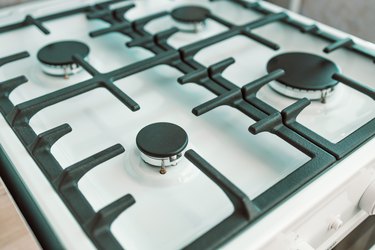
While spills and splatters on the stove top are easy to clean up when they're fresh, if you let them sit a while and they seem plastered in place. Even simple liquids such as coffee leave unsightly stains on a white stove top if they're left to dry. Wipe up these spills, splatters, and stains by starting with the most gentle methods possible, such as vinegar and a damp cloth. Avoid using harsh abrasives, as even though that cook top is durable, it's still prone to scratches if you use the wrong scrubbers.
Start With Soapy Water
Video of the Day
The simplest stains, caused by sauces, soups, or other liquids drying in place, sometimes wipe up with just a little soapy water, as long as you let the water sit long enough to thin the staining substance. Remove the grates from the gas stove top if they might be in the way while cleaning up stains.
Video of the Day
Add a squirt of dish soap to a spray bottle containing warm water; then spray the stains. After 10 minutes or so, wipe the sprayed areas with a damp kitchen sponge. A sponge with a scrub pad on one side is ideal, as the scrubbing side offers enough abrasive power to remove all sorts of substances clinging to the stove top. If the stains are somewhat large, a damp paper towel set over them for at least 10 minutes often does the trick. Follow up with the scrubby sponge.
Create a DIY Abrasive Cleaner
Some food-related stains require a little more abrasive power. Instead of using chemicals, make your own abrasive paste with baking soda, stirring in a little water at a time until the mixture has a paste-like consistency. Spread the paste liberally over all the stains and greasy spots, allowing it to sit for 30 minutes or even a couple hours for stubborn messes.
Spray or drizzle white vinegar over the treated areas, using enough to create a foaming reaction between the baking soda and vinegar. Wait a few minutes; then wipe the mess away with a microfiber cloth or a slightly damp sponge. If slight amounts of grime remain, use a nylon scrubby sponge or a soft-bristled brush to scrub the gunk off. Do not use steel wool or metal pot scrubbers, as these could scratch the stove top.
Scrape Caked-on Gunk
If a food spill hardened in place and you forgot about it for a day or two, don't worry; it's still removable. Gently scrape at the mess from the edges inward using the bowl of a plastic spoon or the edge of a plastic knife. Though it's unlikely that the plastic will scrape the stove top, avoid using excessive force when scraping just to play it safe. The goal isn't to remove all the mess, but to minimize it so you don't have as much to clean up. Hard substances may chip off with ease this way, while gunky, greasy ones lift off the stove for easy removal with a damp paper towel.
Remove any remaining residue by applying the baking soda paste and waiting at least 30 minutes. Follow up with the vinegar spray, wiping it all off with a sponge or soft damp cloth after a few minutes.